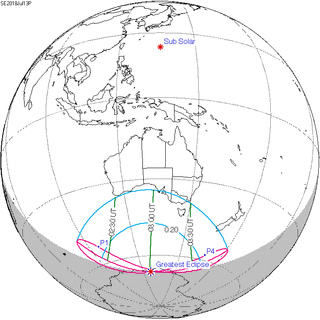Solar eclipse of July 13, 2018
| Solar eclipse of July 13, 2018 | |
|---|---|
 From Melbourne, Australia | |
| Type of eclipse | |
| Nature | Partial |
| Gamma | −1.3542 |
| Magnitude | 0.3365 |
| Maximum eclipse | |
| Coordinates | 67°54′S 127°24′E / 67.9°S 127.4°E |
| Times (UTC) | |
| Greatest eclipse | 3:02:16 |
| References | |
| Saros | 117 (69 of 71) |
| Catalog # (SE5000) | 9548 |
A partial solar eclipse occurred at the Moon's ascending node of orbit on Friday, July 13, 2018,[1][2] with a magnitude of 0.3365. A solar eclipse occurs when the Moon passes between Earth and the Sun, thereby totally or partly obscuring the image of the Sun for a viewer on Earth. A partial solar eclipse occurs in the polar regions of the Earth when the center of the Moon's shadow misses the Earth. The moon's penumbra touched a small part of Antarctica, and southern Australia in Tasmania, where the eclipse was observed with a magnitude of about 0.1. The eclipse was also visible in Stewart Island, an island south of New Zealand.[3]
Images
[edit]Related eclipses
[edit]Eclipses in 2018
[edit]- A total lunar eclipse on January 31.
- A partial solar eclipse on February 15.
- A partial solar eclipse on July 13.
- A total lunar eclipse on July 27.
- A partial solar eclipse on August 11.
Metonic
[edit]- Followed by: Solar eclipse of April 30, 2022
Half-Saros
[edit]- Preceded by: Lunar eclipse of July 7, 2009
- Followed by: Lunar eclipse of July 18, 2027
Tritos
[edit]- Followed by: Solar eclipse of June 12, 2029
Solar Saros 117
[edit]- Preceded by: Solar eclipse of July 1, 2000
- Followed by: Solar eclipse of July 23, 2036
Inex
[edit]- Followed by: Solar eclipse of June 23, 2047
Triad
[edit]- Preceded by: Solar eclipse of September 12, 1931
- Followed by: Solar eclipse of May 14, 2105
Solar eclipses of 2018–2021
[edit]This eclipse is a member of a semester series. An eclipse in a semester series of solar eclipses repeats approximately every 177 days and 4 hours (a semester) at alternating nodes of the Moon's orbit.[4]
The partial solar eclipses on February 15, 2018 and August 11, 2018 occur in the previous lunar year eclipse set.
| Solar eclipse series sets from 2018 to 2021 | ||||||
|---|---|---|---|---|---|---|
| Ascending node | Descending node | |||||
| Saros | Map | Gamma | Saros | Map | Gamma | |
117 Partial in Melbourne, Australia |
July 13, 2018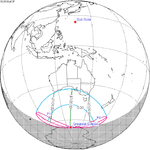 Partial |
−1.35423 | 122 Partial in Nakhodka, Russia |
January 6, 2019 Partial |
1.14174 | |
127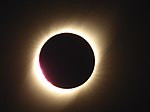 Totality in La Serena, Chile |
July 2, 2019 Total |
−0.64656 | 132 Annularity in Jaffna, Sri Lanka |
December 26, 2019 Annular |
0.41351 | |
137 Annularity in Beigang, Yunlin, Taiwan |
June 21, 2020 Annular |
0.12090 | 142 Totality in Gorbea, Chile |
December 14, 2020 Total |
−0.29394 | |
147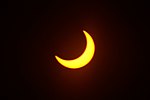 Partial in Halifax, Canada |
June 10, 2021 Annular |
0.91516 | 152 From HMS Protector off South Georgia |
December 4, 2021 Total |
−0.95261 | |
Saros 117
[edit]This eclipse is a part of Saros series 117, repeating every 18 years, 11 days, and containing 71 events. The series started with a partial solar eclipse on June 24, 792 AD. It contains annular eclipses from September 18, 936 AD through May 14, 1333; hybrid eclipses from May 25, 1351 through July 8, 1423; and total eclipses from July 18, 1441 through May 19, 1928. The series ends at member 71 as a partial eclipse on August 3, 2054. Its eclipses are tabulated in three columns; every third eclipse in the same column is one exeligmos apart, so they all cast shadows over approximately the same parts of the Earth.
The longest duration of annularity was produced by member 16 at 9 minutes, 26 seconds on December 3, 1062, and the longest duration of totality was produced by member 62 at 4 minutes, 19 seconds on April 26, 1892. All eclipses in this series occur at the Moon’s ascending node of orbit.[5]
| Series members 57–71 occur between 1801 and 2054: | ||
|---|---|---|
| 57 | 58 | 59 |
 March 4, 1802 |
 March 14, 1820 |
 March 25, 1838 |
| 60 | 61 | 62 |
 April 5, 1856 |
 April 16, 1874 |
 April 26, 1892 |
| 63 | 64 | 65 |
 May 9, 1910 |
 May 19, 1928 |
 May 30, 1946 |
| 66 | 67 | 68 |
 June 10, 1964 |
 June 21, 1982 |
 July 1, 2000 |
| 69 | 70 | 71 |
 July 13, 2018 |
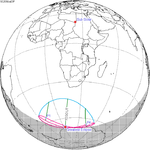 July 23, 2036 |
 August 3, 2054 |
Metonic series
[edit]The metonic series repeats eclipses every 19 years (6939.69 days), lasting about 5 cycles. Eclipses occur in nearly the same calendar date. In addition, the octon subseries repeats 1/5 of that or every 3.8 years (1387.94 days). All eclipses in this table occur at the Moon's ascending node.
| 21 eclipse events between July 13, 2018 and July 12, 2094 | ||||
|---|---|---|---|---|
| July 12–13 | April 30–May 1 | February 16–17 | December 5–6 | September 22–23 |
| 117 | 119 | 121 | 123 | 125 |
 July 13, 2018 |
 April 30, 2022 |
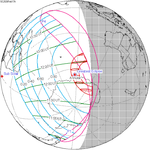 February 17, 2026 |
 December 5, 2029 |
 September 23, 2033 |
| 127 | 129 | 131 | 133 | 135 |
 July 13, 2037 |
 April 30, 2041 |
 February 16, 2045 |
 December 5, 2048 |
 September 22, 2052 |
| 137 | 139 | 141 | 143 | 145 |
 July 12, 2056 |
 April 30, 2060 |
 February 17, 2064 |
 December 6, 2067 |
 September 23, 2071 |
| 147 | 149 | 151 | 153 | 155 |
 July 13, 2075 |
 May 1, 2079 |
 February 16, 2083 |
 December 6, 2086 |
 September 23, 2090 |
| 157 | ||||
 July 12, 2094 | ||||
Tritos series
[edit]This eclipse is a part of a tritos cycle, repeating at alternating nodes every 135 synodic months (≈ 3986.63 days, or 11 years minus 1 month). Their appearance and longitude are irregular due to a lack of synchronization with the anomalistic month (period of perigee), but groupings of 3 tritos cycles (≈ 33 years minus 3 months) come close (≈ 434.044 anomalistic months), so eclipses are similar in these groupings.
| Series members between 2018 and 2200 | ||||
|---|---|---|---|---|
 July 13, 2018 (Saros 117) |
 June 12, 2029 (Saros 118) |
 May 11, 2040 (Saros 119) |
 April 11, 2051 (Saros 120) |
 March 11, 2062 (Saros 121) |
 February 7, 2073 (Saros 122) |
 January 7, 2084 (Saros 123) |
 December 7, 2094 (Saros 124) |
 November 6, 2105 (Saros 125) |
 October 6, 2116 (Saros 126) |
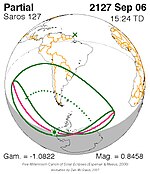 September 6, 2127 (Saros 127) |
 August 5, 2138 (Saros 128) |
 July 5, 2149 (Saros 129) |
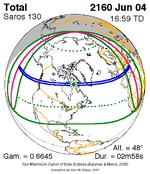 June 4, 2160 (Saros 130) |
 May 5, 2171 (Saros 131) |
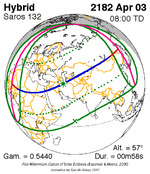 April 3, 2182 (Saros 132) |
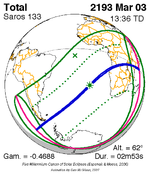 March 3, 2193 (Saros 133) | |||
Inex series
[edit]This eclipse is a part of the long period inex cycle, repeating at alternating nodes, every 358 synodic months (≈ 10,571.95 days, or 29 years minus 20 days). Their appearance and longitude are irregular due to a lack of synchronization with the anomalistic month (period of perigee). However, groupings of 3 inex cycles (≈ 87 years minus 2 months) comes close (≈ 1,151.02 anomalistic months), so eclipses are similar in these groupings.
| Series members between 1844 and 2200 | ||
|---|---|---|
 November 10, 1844 (Saros 111) |
||
 September 12, 1931 (Saros 114) |
||
 July 13, 2018 (Saros 117) |
 June 23, 2047 (Saros 118) |
 June 1, 2076 (Saros 119) |
 May 14, 2105 (Saros 120) |
 April 24, 2134 (Saros 121) |
 April 3, 2163 (Saros 122) |
 March 13, 2192 (Saros 123) |
||
References
[edit]- ^ "A Supermoon Partial Eclipse Is Happening Just in Time for Friday the 13th". Popular Mechanics. July 13, 2018.
- ^ Padgett, Lauren. "Friday the 13th solar eclipse only visible to rare few" – via AJC.com.
- ^ "Partial Solar Eclipse on July 13, 2018". www.timeanddate.com. Retrieved July 13, 2018.
- ^ van Gent, R.H. "Solar- and Lunar-Eclipse Predictions from Antiquity to the Present". A Catalogue of Eclipse Cycles. Utrecht University. Retrieved 6 October 2018.
- ^ "NASA - Catalog of Solar Eclipses of Saros 117". eclipse.gsfc.nasa.gov.

